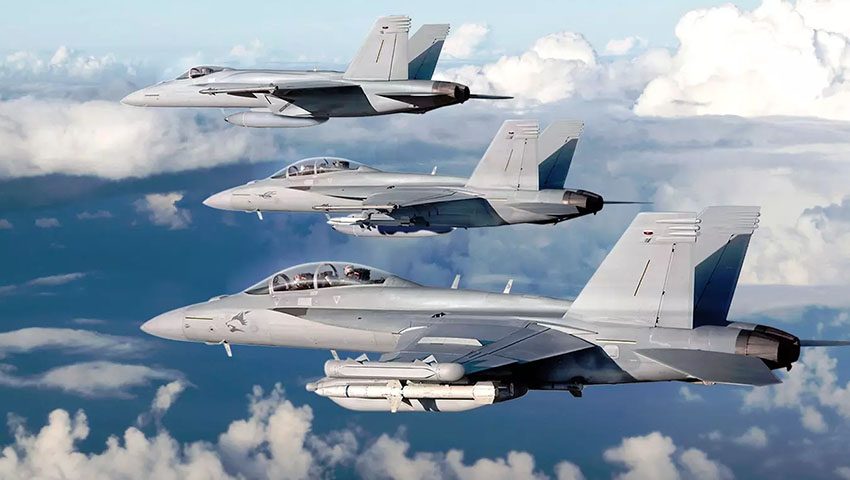Boeing’s Block III upgrades for the Super Hornet platform will enhance the interoperablity of 4th and 5th generation strike and air combat capabilities of many air forces, with the RAAF’s Super Hornets prime candidates for the modernisation program.
To continue reading the rest of this article, please log in.
Create free account to get unlimited news articles and more!
Increasing the interoperability and lethality of 4th and 5th generation combat aircraft is dramatically shifting the way contemporary air forces operate in the 21st century battlespace.
Boeing’s Block III Super Hornet upgrades recognise the growing importance and role operating legacy platforms, like the 4.5 generation Super Hornet platform with 5th generation fighter aircraft like the F-35 Joint Strike Fighter.
In light of this, both Boeing and the US Navy, the primary operator of the Super Hornet platform, established the Block III Super Hornet concept to work as an effective partner for the US Navy’s fleet of carrier-capable, low-observable F-35Cs.
This concept is similar to the emerging “high-low” capability concept being developed by the US Air Force, which seeks to operate 4th, 4.5 and 5th generation aircraft in complementary roles, leveraging the unique strengths of the various platforms.
Defence Connect first introduced the high-low combination of aircraft in late 2018 following an announcement by the Pentagon introducing the F-15X, a heavily modified and modernised variant of the F-15E Strike Eagle variant, which would see the F-15X, “seamlessly plug[ing] into their existing air combat infrastructure as part of better-defined high-low capability mix strategy”.
To serve in this role, the Block III upgrades to the Super Hornets incorporate a range of capability upgrades, including:
- The Lockheed Martin Mobile User Objective System (MUOS) satellite communications (SATCOM) link to share targeting data with friendly forces operating outside the range of line-of-sight radio communications.
- A specialised Tactical Targeting Network Technology (TTNT) network, developed by Rockwell Collins, currently operating on the EA-18G Growler and the E-2G Hawkeye airborne early warning and control (AEW&C) aircraft, allowing for the rapid transfer of large volumes of data even in contested environments. The TTNT system also enables the Super Hornet to act as part of an integrated Naval Integrated Fire Control - Counter-Air system, enhancing the lethality and survivability of surface combatants.
- A specialised Infrared Search and Track (IRST) sensor, which would provide Block III Super Hornets with an air-to-air combat advantage through specialised tracking capabilities, allowing a single aircraft to locate the direction of an enemy combatant beyond visual range (BVR) with two Super Hornets able to triangulate the precise location of the enemy aircraft.
- An Advanced Cockpit System (ACS) enabling a form of data fusion, drawing together sensor information to be displayed to the pilot in a clear and intuitive picture.
- Conformal Fuel Tanks (CFT) developed by Boeing in partnership with Northrop Grumman, enabling an increased range of approximately 120 nautical miles (222km) without impacting aerodynamic performance.
Additionally, the Block III Super Hornets will receive a 10 per cent in radar cross section (RCS), enabling high rates of survivability and low-observability in contested and heavily defended, integrated air defence (IAD) networks. However, these RCS improvements would be negated by increased under-wing armament capacity.
The Block III upgrades also include an upgrade to the existing F414 engine, providing a 20 per cent increase in thrust with improved fuel economy, complimenting the introduction of the conformal fuel tanks, while the life of the airframe will be increased from 6,000 flight hours to approximately 9,000 flight hours.
Australia currently operates a fleet of 24 F-18 E/F Super Hornet with 11 E/A-18G Growler aircraft, originally acquired to prevent a capability gap between the retirement of the RAAF’s legacy F-18 A/B Hornets and the introduction of the F-35A Joint Strike Fighter.
Australia’s fleet of Super Hornets and Growlers have established themselves as a world-leading capability following deployments in support of allied air operations in the Middle East and APEC 2018.
The enhancements designed as part of the Block III new build/modernisation plan would enable Australian Super Hornets to serve in conjunction with RAAF F-35s and broader coalition operations utilising a combination of 4th, 4.5 and 5th generation combat aircraft to overcome the evolving threat environments currently developing around the world, but critically, Indo-Pacific Asia.
Stephen Kuper
Steve has an extensive career across government, defence industry and advocacy, having previously worked for cabinet ministers at both Federal and State levels.

 Login
Login








